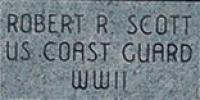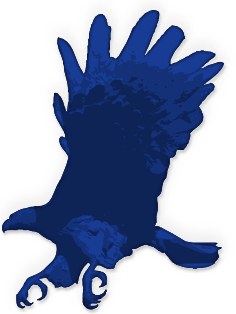Military Veterans

Robert Raymond Scott
Date of Birth
10 January 1927
Date of Death
8 June 2000
Brick Location
Eagle Side
Panel Number
9A

Biography
The story of how Seaman First Class Bob Scott entered the service in World War II is interesting. The following account is recorded in his autobiography
The Life and Times of Bob Scott by Robert Raymond Scott, El Dorado, KS 1998.
In May, 1944, Bob graduated from El Dorado High School…
Joining the Coast Guard
"The war was going on. I was still working at Morris Oil Company, but I wasn't satisfied. I was a year younger than most of my friends and they had already gone to the service. So it was a little lonely around town.
Then I got to the point where I really wasn't satisfied to be at home and go to work. I wanted something better.
In November, 1944, I drove to Kansas City. I decided I wanted to join the Army Air Corps. But I was only 17 years old and the Army said, 'No, you have to be 18.'
But there was a U. S. Coast Guard enlistment place nearby. They said, 'Yeah, we'll take you at age 17, but we don't think you're heavy enough.' So they weighed me. I weighed 122 pounds. The recruiter said, 'Sorry. You have to weigh 125 pounds.'
But then he added, 'Why don't you go down the street there, drink a malt, and eat a banana. Do something to add a little weight, and come back. We'll sign you up.'
Which I did. And which they did. I may have been short of 125 pounds, but (for the record) I was probably five foot eight inches tall, and weighed 125 pounds.
California, Here I Come!
A couple of weeks later, I got on the train and traveled from Kansas City to San Diego. From San Diego, we went to Catalina Island…that is Santa Catalina, California! The United States Maritime Service came under the jurisdiction of the U. S. Coast Guard. Even though I joined the Coast Guard, I was to take my boot camp under the U. S. Maritime Service.
After boot camp, I was transferred into the U. S. Merchant Marines, and that was where I wanted to go. We went by boat 25 miles from San Diego to Catalina Island, where we took our basic training. I was still there when I turned 18 on January 10. That was 1945. Finished boot camp and went by train to Portland, OR. Having transferred into the Merchant Marines, we went to what was called graduate school. Just more training is what it amounted to.
Then we were assigned to a ship. It was a merchant ship. On a merchant ship, there were only 45 to 50 personnel. It was called a 'liberty' ship. It was 300 to 350 feet long…We had a 12-man Navy gun crew.
Life At Sea
When we finished our graduate training, we left Portland and went to Hawaii. We were in convoy. (Convoy means you're with a number of other ships.) The war with the Japanese was still going on.
This was just a short trip. We went into Pearl Harbor, where the war started. A pilot (guide) directed us through these waters. You could not believe the many vessels laid waste. A big share of the U. S. Fleet was anchored at Pearl Harbor when the Japanese attacked and that was why they chose that particular place.
We were in Pearl Harbor for a short time, then returned to Tacoma, WA. Then went on to the Marianas.
There were lots of Japanese submarines to watch out for. We came to an island out there in the Pacific called Eniwetok. I'm not sure where the convoy was headed, but we left the convoy at that point and we went to the Marianas—Guam, Tinian, Saipan—they had just been liberated. From there we went to the Philippine Islands. We anchored out off of two or three different islands there; I don't remember their names.
We had unloaded our supplies, which were Seabee supplies, in the Marianas. The Seebees made up a construction battalion. When the islands wre liberated, then someone has to build them back up, you might say. Basically, the Seabees built air strips because planes were so important. We were one of thousands of ships that were hauling this Seabee equipment.
I had in my possession a small Bible. It was a New Testament. And in it I had written down these particular trips—just dates…
From the Philippines, we went to Melanie Bay, New Guinea. We loaded up again and would shuttle supplies to these different islands (after they were secured). We would go in as close as we could get to the beach, and the Navy would send out ships, load them up with supplies, and take them back. These were LST's and I don't know what all.
So we'd go to these different islands that had been secured for quite awhile, where all of the supplies were stored. We'd load up these building materials again and go to the newly secured islands and unload there. That was our mission until the war was over, August 15, 1945.
My job: I was stationed at the three-inch forward gun. I was the first loader. My rating was Seaman 2nd Class. …
On one particular trip from the Philippines to New Guinea, the northern part of New Guinea, we were 10 miles off the coast, going south. On the northern part of New Guinea, there was this volcano. We watched it erupt; we didn't hear the sound, but we could see all of this molten lava that was pouring out of the side of the mountain. We watched it all night. It was dark, of course, but you could see that molten lava that was going down the side of the mountain.
A couple of nights later, we were still going along the coast of New Guinea, and the call came: 'All hands to!'…which means to go to your gun stations. It was just before daylight, early in the morning. I was sleeping back in the gun tub. What it was, there were three American PT boats, and they were making mock runs on our ship. When it's about half light, the lookout saw something and he pulled general quarters, all stations. Which was fortunate. We would have been sunk in a hurry. I don't think we even got our shoes on by the time they had made their run. Those little ol' skeeter boats, they move right on out. And they were in and gone before we got our britches on.
We had a lot of exciting times, but nothing crucial or dangerous.…Life went on and on…We got up and did what we had to do. We ate and took our showers in sea water and rinsed off with fresh water. We were called to our gun stations, but we never had to fire a shot in anger. We practiced, but nobody ever attacked us. We weren't worth it, I don't think…"
Branch:
U.S. Coast Guard
Rank
Seman 1st Class
Years
World War II

